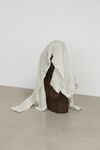Christian Andersen, Frederiksholms Kanal 28A, 1220 Copenhagen K, +45 2537 4101, info@christianandersen.net
Images
Press release
Dear Gallerist,
I hope this letter finds you well and that the works Marie has sent to you have arrived in good spirits. They left the studio we share on Tuesday to travel in a van for a couple of days before residing temporarily at your gallery. The objects can be considered as common objects or at least that is how they behaved in our studio, when they were ‘hanging out’ in the corner, sometimes silently, sometimes frantic. As I was observing them from behind my desk I saw the group growing, their positions altering, and their features developing. I saw them hinting at certain functions but then resisting to fulfil these aims. A couple of them received a glass front, two-dimensionally positioned as if they only wanted me to know them from the spot I was watching them. But then to make the trip to you they changed. Some got filled with non-art material, one was rolled up and another one placed in a box which was slightly too small.
This transition and preparation for travel showed their mobility, their impractical functionality. This development made me wonder, and that is also why I’m writing to you to ask you how they are at your place? I suppose you will unpack them, open them up and empty them out. You might place them around the gallery and walk around them. As an investigator, you will possibly try to read them and create a relationship with the work. Or perhaps you prefer to pose questions upon them: What are you telling me? Is there something embodied in your materiality? Or should I look into in your object-hood? Are you singular or do you prefer to exist as a group? My apologies, if me imagining what you, will do forces a certain behaviour upon you; almost as if you were the object of interest.
But then in the process of making sense, of generating a bond, these objects might turn their back on you. They do not really want to move in, they resist taking up space or simply, bluntly oppose your investigation. They are reluctant to conform to any assumed or prescribed model of behaviour, in the same way you might have felt when I envisaged certain actions on your part.
But lets stick to the objects: As I know them, they only reveal themselves frontally, two-dimensionally, in a plane and in an instant. They present the object in a single glance, as if the objects aim at being images. As you stand there in front of them, and are given that specific perspective, within a certain moment, they might …
Containers. Weight. Hollow. Surface. … Plinth. Crate. Box. Gallery. … as objects, rooms, houses. Common objects, existing outside of us, without us knowing them, without us having encountered them. In the corner of a room, they reveal themselves, they hide, they resist, they …
… slip into the shadow of a shape that once was …; embody a shape through the drawing of its contours …; a two-dimensional sculpture - appearing in the movement of our mind…;
… and yet exist in their own materiality or spatial potential.
I once read about this author that remembers other peoples memories. In the story this blocked the author from writing as he couldn’t consider any possible outcome as his own. The memories were so rich that he had to project them onto every single object he encountered. They became actions, not in the past but in the present. And they were shared by the object and the potential observer. As such I’m asking you to talk me through the work to see if our thoughts, our projections and memories might coincide.
Kind regards and success with the exhibition,
Pieternel Vermoortel





